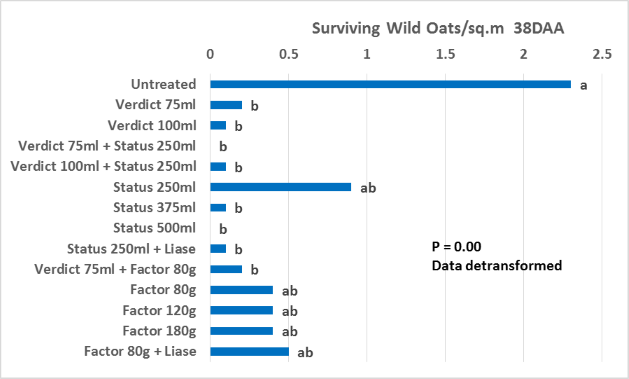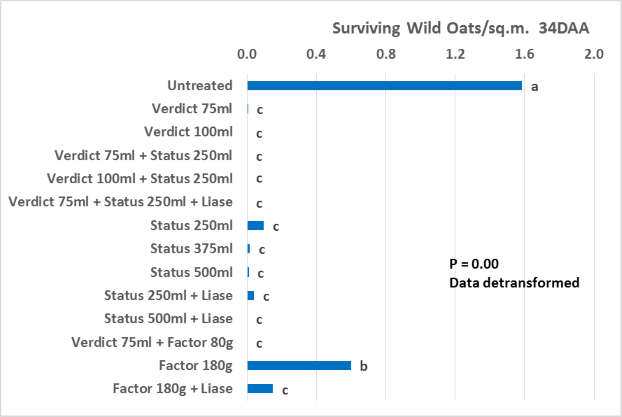NGA chickpea herbicide trials 2014
Author: Lawrence Price, Anthony Mitchell, Rachel Norton, Linda Bailey (Northern Grower Alliance) | Date: 24 Jul 2015
Take home messages
- Factor® (250g/kg butroxydim) was not effective as a knockdown for wild oats in chickpeas.
- Of the Group A herbicides, 500 mL/ha of Status® (240g/L clethodim) or mixtures of Verdict® (520g/L haloxyfop) plus Status proved the most effective brews for knockdown control of wild oats
- Clethodim (as Status) benefited from the addition of Liase® even when rain water was used as the carrier
- Screening of new herbicide registrations in chickpeas has not yet shown consistently robust options for the residual control of wild oats and key broadleaf weeds
Weed control has always been a critical part of chickpea management. This paper reports on recent trial activity for the management of a range of weeds in chickpeas; primarily wild oats (both Group A resistant and susceptible populations) but also other grass weeds and problem broadleaf weed species.
Wild oat ‘knockdown’ control
In reviews of the 2013 winter season, agronomists and farmers had raised managing resistant populations of wild oats as a major issue for the region. Wild oats are a key weed of winter crops throughout the region and for the past 30 years growers and agronomists have relied on Group A herbicides for control.
Haloxyfop a ‘fop’ herbicide is perhaps the most widely used herbicide in the region for knockdown of wild oats in chickpeas and other pulse crops, however resistance to this herbicide is becoming increasingly frequent. Many agronomists, where they have concerns about the Group A resistance status of wild oats in a paddock, will mix haloxyfop (e.g. Verdict 520) with a ‘dim’ herbicide (most commonly clethodim), other agronomists might use clethodim alone. NGA was questioned as to what was the best strategy to use.
Butroxydim (e.g. Factor) is another Group A ’dim’ that although registered for wild oat control in many broadleaf crops has not been widely used in the Northern NSW/Sth Qld region. Reports have filtered up from southern Australia that in some situations butroxydim is the last group A herbicide effective against annual ryegrass. The question was asked “Could butroxydim have similar attributes against wild oats in our region?”
What was done?
In 2014 the NGA team conducted 4 small plot replicated trials looking at control of wild oats in chickpeas with knockdown herbicides.
Trials were situated in commercial chickpea paddocks near Mungindi, North Star, Bowenville and Edgeroi. The Mungindi and North Star sites were known to have wild oats with resistance to haloxyfop.
Aims of the trials were:
- Does mixing haloxyfop with clethodim give an advantage in wild oat control compared to either product applied alone?
- Can we get equal benefit by just increasing the herbicide rate?
- Does butroxydim control fop resistant weed populations, in a similar way to clethodim?
- Is there an advantage in adding ammonium sulphate (as Liase) to the ‘dim’ herbicides?
Table 1. Spray dates, growth stage of wild oats and water quality of trials conducted in 2014
|
Site |
Spray date |
Wild Oat Growth stage at spraying |
Water source |
Bicarb ppm |
|
Mungindi |
July 1 2014 |
2 – 4 leaves |
Goondiwindi Town water |
104 |
|
North Star |
June 26 2014 |
3 – 5 leaves |
Goondiwindi Town water |
104 |
|
Bowenville |
August 11 2014 |
Up to 3 tillers |
Rain water |
18 |
|
Edgeroi |
September 4 2014 |
Up to 7 tillers |
Gunnedah Town water |
low |
Table 2. Products used in trials
|
Trade name |
Active ingredient |
Formulation |
Herbicide or adjuvant |
|
Verdict® 520 |
Haloxyfop |
520 g/L |
Herbicide |
|
Status® |
Clethodim |
240 g/L |
Herbicide |
|
Factor® |
Butroxydim |
250 g/kg |
Herbicide |
|
Uptake® |
Paraffin oil + |
582 g/L + |
Adjuvant |
|
Supercharge® |
Paraffin oil |
471 g/L |
Adjuvant |
|
Liase® |
Ammonium sulphate |
417 g/L |
Adjuvant |
Applications were made with quad bike mounted booms. In all cases using AIXR110015 nozzles at 50 cm spacing and a water volume of 70 L/ha.
Uptake was added to all tank mixes containing Verdict or Status at a rate of 0.5%
Supercharge was added at 1% to treatments of Factor (But not when tank-mixed with Verdict)
Results
Trial RN1419 Mungindi

Figure 1. Surviving wild oats per square metre at 43 days after application at Mungindi trial
Uptake 0.5% added to all treatments containing Verdict or Status, Supercharge 1% added to all treatments ONLY containing Factor. DAA = days after application
Summary
- Verdict applied alone failed to give effective control
- Addition of 250 ml/ha of Status to the 75mL/ha rate of Verdict improved efficacy compared to Verdict applied alone at the same rate
- Factor applied alone or as a tank-mix with Verdict failed to give effective control
- Status was the most effective herbicide
- There was a non-significant rate response for Status.
- Addition of Liase trended to improve the performance of Status, but not Factor, in low bicarb water
Trial RN1420 North Star

Figure 2. Surviving wild oats per square metre at 47 days after application at North Star trial
Uptake 0.5% added to all treatments containing Verdict or Status, Supercharge 1% added to all treatments ONLY containing Factor. DAA = days after application
Summary
- Similar pattern of results to the Mungindi site
- Verdict applied alone failed to give effective control
- Factor applied alone or as a tank-mix with Verdict failed to give effective control
- The Verdict + Status tank-mix gave the best level of control
- There was a significant rate response for Status.
- Addition of Liase significantly improved the performance of Status but not Factor
Trial LB1409 Bowenville

Figure 3. Surviving wild oats per square metre at 38 days after application at Bowenville trial
Uptake 0.5% added to all treatments containing Verdict or Status, Supercharge 1% added to all treatments ONLY containing Factor. DAA = days after application
Summary
- Verdict gave effective (although not complete) control of wild oats at this site
- Factor applied alone was not considered commercially acceptable giving ~ 80% reduction in surviving plant numbers. Factor gave no improvement when tank-mixed with Verdict compared to Verdict applied alone
- The Verdict + Status tank-mixes gave very good control, with complete control achieved by the nix of 75ml/ha of Verdict and 250 ml/ha of Status
- There was a non-significant rate response for Status.
- Addition of Liase trended to improve the performance of Status, but not Factor – even though rain water was the carrier
Trial AM1409 Edgeroi

Figure 4. Surviving wild oats per square metre at 34 days after application at Edgeroi trial
Uptake 0.5% added to all treatments containing Verdict or Status, Supercharge 1% added to all treatments ONLY containing Factor. DAA = days after application
Summary
- Treatment list was changed at this site following earlier results
- Verdict either alone or in mixture gave excellent control of wild oats at this site
- Factor applied alone at 180 g/ha only provided an unacceptable 60 % reduction in wild oat number
- As in the other trials there was a rate response for Status however this was not statistically significant. The addition of Liase trended to improve the performance of Status
Conclusions wild oat knockdown control
Remarkably similar responses considering the different resistance profiles of the wild oat populations.
- Verdict (alone) provided good control of the Bowenville and Edgeroi populations, despite these being substantially larger weeds, thus indicating ‘fop’ susceptible populations
- Factor applied alone was not effective at any of the sites.
- Addition of 250 mL/ha of Status to Verdict improved efficacy where the haloxyfop resistance was in question
- Addition of Factor to Verdict did not improve efficacy to acceptable levels
- A numerical rate response for the herbicide Status was indicated in all trials, although mostly this was not significant
- There was a Liase response when added to Status, but not to Factor, irrespective of the water quality
Grass ‘residual’ control
NGA established seven trials in winter 2014 to evaluate the potential of new chemistry on residual management of key grass weed species. Weed data was generated at four sites with efficacy against wild oats, windmill grass and liverseed grass (germinating in the spring).
Although most of the herbicides provided some level of suppression of wild oats, none provided a commercial level of control, with TriflurX® (480g/L trifluralin) at 1.7 L/ha providing the highest level of control. Two of the four sites however had a level of cultivation in recent seasons and this may have impacted on the level of control by having weed seeds spread through the soil profile with seeds at depth not being well controlled from an incorporated by sowing (IBS) application.
At a site near Condamine sprayed in mid May 2014, useful data was obtained on liverseed grass management. The liverseed grass emerged in late August/early September nearly 4 months after herbicides were applied as an IBS application at planting. The most effective herbicides were from the dinitroanilines class (pendimethalin (e.g. Stomp®) or trifluralin (e.g. TriflurX).
An additional series of 9 trials targeting activity on wild oats, awnless banyard grass and feathertop Rhodes grass are underway in 2015.
Broadleaf ‘residual’ control
Two trials were established in 2014 to evaluate the potential of new chemistry on residual management of key problem broadleaf weeds. Data was generated on Mexican poppy, climbing buckwheat as well as common sowthistle. Useful suppression was achieved from a number of newly registered chickpea herbicides and additional trials are underway in 2015.
Acknowledgements
The research undertaken as part of this project is made possible by the significant contributions of growers through both trial cooperation and the support of the GRDC, the author would like to thank them for their continued support.
Contact details
Lawrence Price
Northern Grower Alliance
Ph: 07 4639 5344
Email: lawrie.price@nga.org.au
® Registered trademark
GRDC Project Code: NGA00003,
Was this page helpful?
YOUR FEEDBACK
